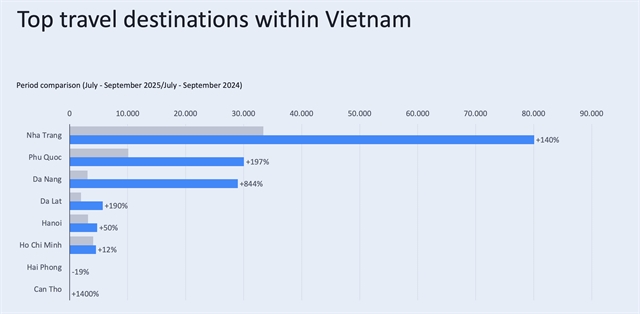 Society
Society

 |
| A Vietnamese language period at the Laos-Việt Nam Friendship School in Laos’ Champasak Province. — VNA/VNS Photo Bá Thành |
Xuân Tú-Bá Thành
HÀ NỘI — Lessons in friendship are taking shape as the Laos-Việt Nam Friendship School in Champasak Province welcomes hundreds of students each year, not only teaching the Vietnamese language but also instilling pride in culture and the close bonds between the two peoples.
As the economic centre of southern Laos, Champasak is home to a large Vietnamese community that has lived, studied and worked there for many generations.
Alongside this presence, Vietnamese language education in the region has long served as an important bridge, helping Vietnamese descendants preserve their mother tongue while strengthening the special friendship between Việt Nam and Laos.
As the 2025-2026 school year begins, the Laos-Việt Nam Friendship School’s campus in Champasak Province buzzes with the sound of the school drum mixed with the laughter and chatter of students, both overseas Vietnamese and Lao, creating an excited and lively atmosphere.
More than just a place for regular classes, the school is a nurturing ground for a love of the Vietnamese language, fostering dreams and preserving the close teacher-student bond through every lesson.
The eyes of Nguyễn Thị Hải Yến, whose Lao name is Nanivanh Sengchanh, a sixth-grade student, sparkle with passion when she talks about her favourite subject.
Hải Yến loves studying Vietnamese because she said she hoped to continue her education in Việt Nam in the future.
For Hải Yến, every poem and story in Vietnamese opens doors to new dreams and opportunities. This innocent passion vividly reflects the growing enthusiasm for learning Vietnamese in Champasak.
Strong special friendship
The Laos-Việt Nam Friendship School was established in 1978.
After nearly half a century, the school has educated more than 43 generations of students, becoming a shared home for nearly 500 children from kindergarten through junior secondary school.
About 20 per cent of these students are children of Vietnamese families living in the area.
A special feature of the school is the incorporation of Vietnamese as an official subject from the primary level, taught by a dedicated team of teachers, including both Vietnamese and Lao educators who have been trained at universities in Việt Nam.
For the school’s teaching staff, instructing Vietnamese is not only a professional duty but also a responsibility and an emotional commitment.
“Teaching Vietnamese is both a responsibility and a sacred affection. It is our way of contributing to the preservation and promotion of Vietnamese culture and further strengthening the special friendship between the two nations,” said Soukdavanh Tanphanith, a Lao teacher of Vietnamese.
In addition, the school organises many meaningful activities to encourage students to love and practise Vietnamese. Contests on Vietnamese language knowledge and storytelling competitions in Vietnamese, launched by the Vietnamese Consulate General in Pakse City in Laos, have attracted active participation from the students.
Every year, many students from the school achieve high ranks in provincial excellent student competitions, demonstrating clear progress in the movement to learn Vietnamese in Champasak.
According to Deputy Principal of the school Đặng Thị Cúc, thanks to the care of the Vietnamese Communist Party and Government, along with support from Vietnamese provinces and cooperation from Vietnamese businesses in the area, the school has been equipped with modern facilities such as computers, projectors and educational robots to support subjects like maths, English, Vietnamese and science.
Students now have a more dynamic learning environment that meets the educational reform requirements set by the Lao Government.
Currently, each class has six Vietnamese lessons per week. More importantly, through every lesson, teachers strive to instil in students a love for the Vietnamese language, culture and history, helping them deepen their understanding of their roots and strengthen their connection to their homeland.
Speaking to a Vietnam News Agency’s reporter in Laos, Tạ Phương Dung, Vietnamese Consul General in Pakse City, said that teaching and learning Vietnamese in southern Laos, as well as in Champasak Province, had always been emphasised and had become increasingly profound.
In the province, Vietnamese is taught at several exemplary educational institutions, such as the Champasak-Lâm Đồng High School for Gifted Students (often called Phonesavanh School) and the Champasak Provincial Boarding School for Ethnic Students, according to Consul General Dung.
These are schools with rich traditions, serving as a common home for many generations of Vietnamese-Lao students, where the Vietnamese language becomes a bridge that connects the community, helping Vietnamese students integrate while preserving their cultural identity.
To improve teaching quality, schools have actively sent teachers to participate in professional training courses, notably those organised by the Consulate General in March and by the State Committee for Overseas Vietnamese under the Ministry of Foreign Affairs of Việt Nam in August.
These practical activities help teachers update their knowledge and innovate teaching methods, thereby improving learning outcomes for students.
Vietnamese language teaching and learning in Champasak Province has achieved many important results in recent years. It is not only about preserving the mother tongue for young Vietnamese living away from their homeland but also vividly demonstrates the close and loyal relationship between Việt Nam and Laos.
Every classroom and every Vietnamese lesson in Champasak Province carries the meaning of a bridge connecting the past with the present, fostering an increasingly strong special friendship. — VNS